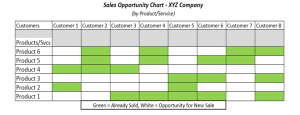Now that the new year is upon us and we all have new sales quotas, we need a plan to build our sales pipelines in order to get in front of enough prospects to exceed our goals. Here is a 5-step plan to build your sales pipeline.
Step 1 - Are you hanging out where your qualified prospects are hanging out?
Whether you are networking physically (in-person) or virtually (online), are you really networking with qualified prospects – your target market? I’ve seen too many people networking with groups (in-person and online) where there are too few of their targeted prospects. If you are trying to connect with CEOs of certain sized companies, but the organization with which you are networking attracts mainly accountants or IT professionals, you should re-examine the situation. Ask yourself – am I involved in organizations where my targeted prospects are? If not, find and get involved with the right networking groups.
Joining LinkedIn groups is the online version of networking. Are you a member of the best groups that align with your target market? If your answer is “yes”, then are you providing original and compelling content in those groups, answering member questions, and being a valuable source within the group? If not, you need to re-examine the group and how you are adding value to it. Once again – are you a member of the right LinkedIn groups and are you a member that stands out from the rest?
Step 2 - Do you have a targeted prospect list?
The best sales professionals always have a list of prospects they want to meet. If you don’t, you run the risk of waiting for the next lead to fall into your lap – not exactly a good plan to make your quota. Depending on the size of your average sale and/or how many sales you need to make in a given period of time, your prospect list may have as few as 10 or as many as 100 or more. The important thing is to have a prospect list. Here are three ways to develop a prospect list…
- Go to Sales Genie, InfoUSA or one of the other online business information sites. Input your criteria and purchase a list of prospects that align with your target market. The investment isn’t much when you consider the potential sales.
- Scan through member lists of business and trade organizations, and pick out those who appear to be aligned with your target market.
- Scan through phone books and newspapers to identify prospect companies, be observant when you are driving around, make note of the names on doors when you are in office buildings, and simply jot down names of companies as you navigate throughout your days.
Are you working your prospect list?
Now that you have a list names and companies you want to meet, are you actively working it every day? When you are networking with other individuals, are you reviewing your prospect list with them? When you are meeting with existing clients, are you asking them if they know anyone on your prospect list and can be a reference? Are you searching in LinkedIn for people with whom you are connected and they are connected to someone on your prospect list?
Once you exhaust your efforts to connect with prospects through your current networking activities, begin contacting the remaining prospects on your list. To increase your success at cold-calling, go to http://www.webstrategiesinc.com/sales/cold-calls-standing-out-from-the-competition and learn about what buyers seek when being contacted.
Step 3 - Are you capturing email addresses?
At every opportunity, capture a prospect’s email address. However, don’t become another annoying “spammer”, but rather use contact information with care. When you meet a new prospect, send him a “thank you” note, or an article or resource that pertains to an issue he has. Something of value will set you apart from the rest. Send him a link to your last newsletter and ask permission to add him to your email database. If you behave like you respect the prospect’s time and privacy, you’ll likely get a warm reception.
In a recent survey, buyers reported email as their most preferred way to receive information about products and services. So, use your email database to keep your prospects informed and to nurture your qualified leads through the buying funnel.
Step 4 - Are you qualifying your leads and only working the qualified ones?
Once you obtain enough information about your prospect, you should qualify how good of a lead they are. Here is the “BARTS” method you can use to qualify a lead…
- B – Do they have the Budget you require?
- A – Do they have the Authority to make a decision?
- R – Will what you sell them generate enough Revenue?
- T – Does their Timing make them a relevant prospect?
- S – Will your Solution bring true value to them?
If your prospect meets the “BARTS” criteria, they are worthy of your time to nurture them through the buying funnel. If they don’t qualify, don’t invest too much time until they do.
Step 5 – Evaluate your existing customers for sales opportunities
Past surveys support that it is 5 times easier to sell to an existing customer, than to acquire a new one. So, evaluate your existing, satisfied customers to determine how you can add more value to them. We recommend you create an Opportunity Chart – see image below – that shows what you are providing your existing customers and where the opportunities are to provide more products/services to improve their business.

Once you complete your Opportunity Chart, you have a roadmap for generating sales and adding value to people who already know and like you.
Follow these 5 steps to create your sales pipeline and you’ll be well on your way to achieving your sales goals in the new year.





Agree, disagree, or just have something to add?
Leave a comment below.